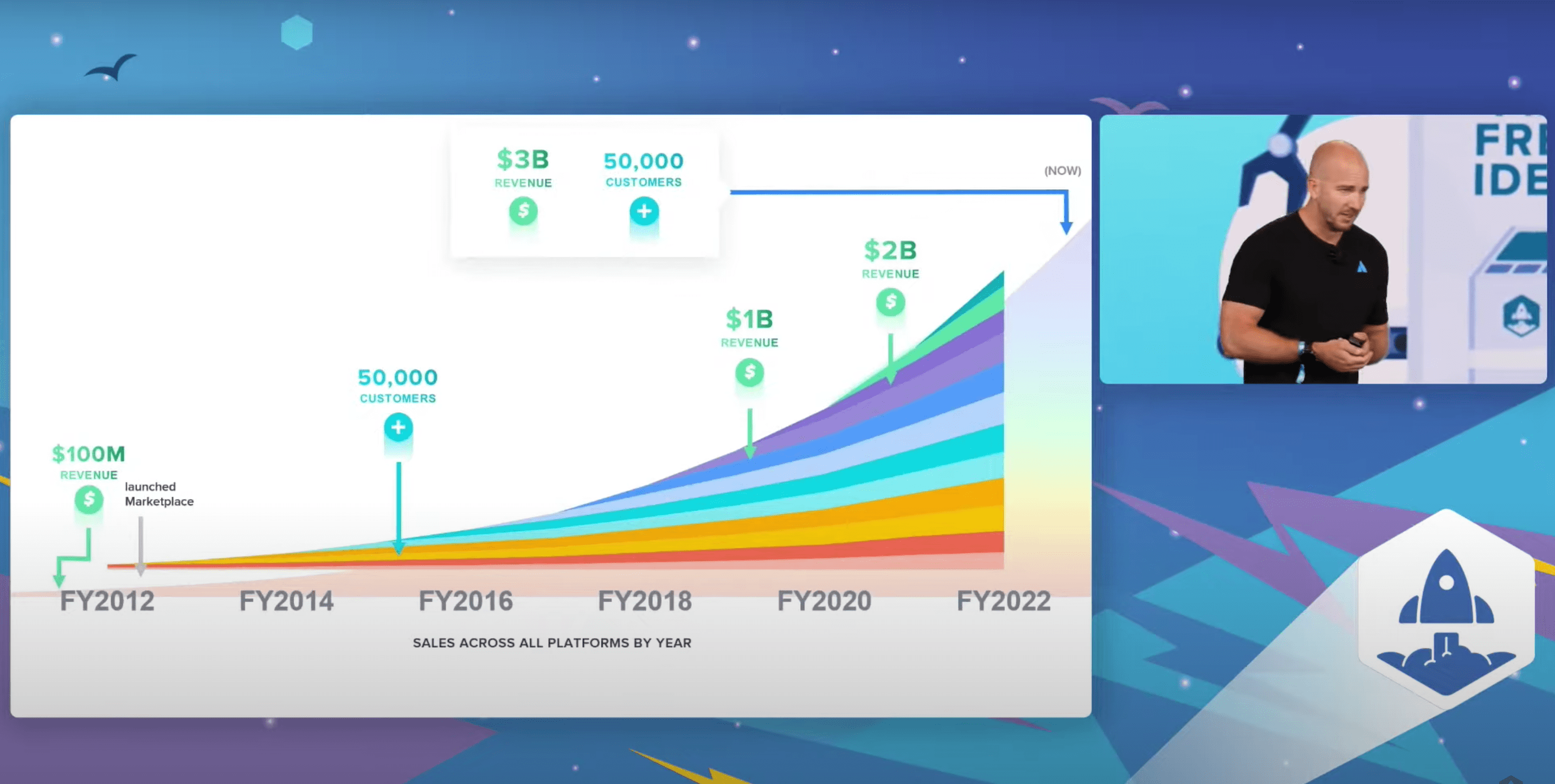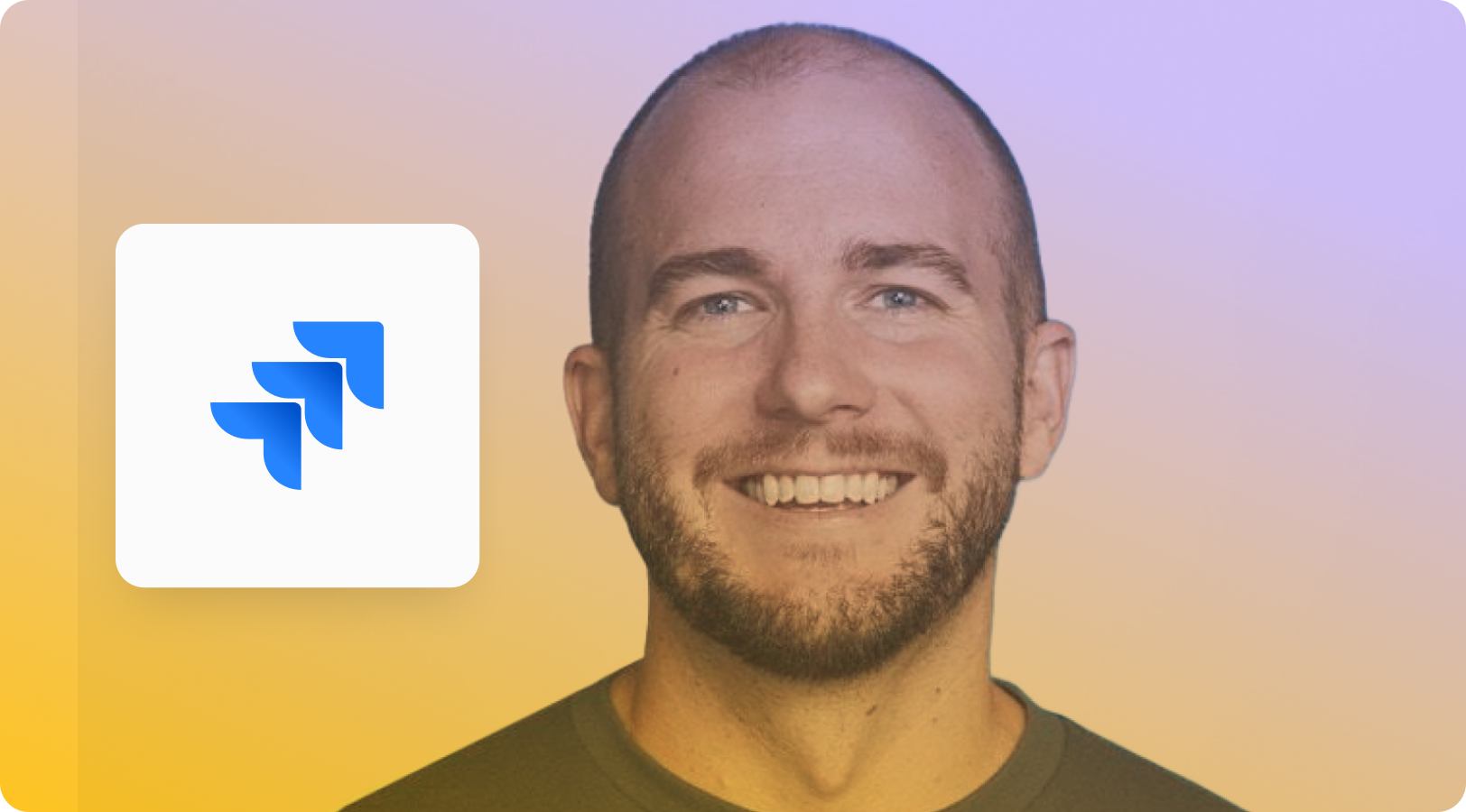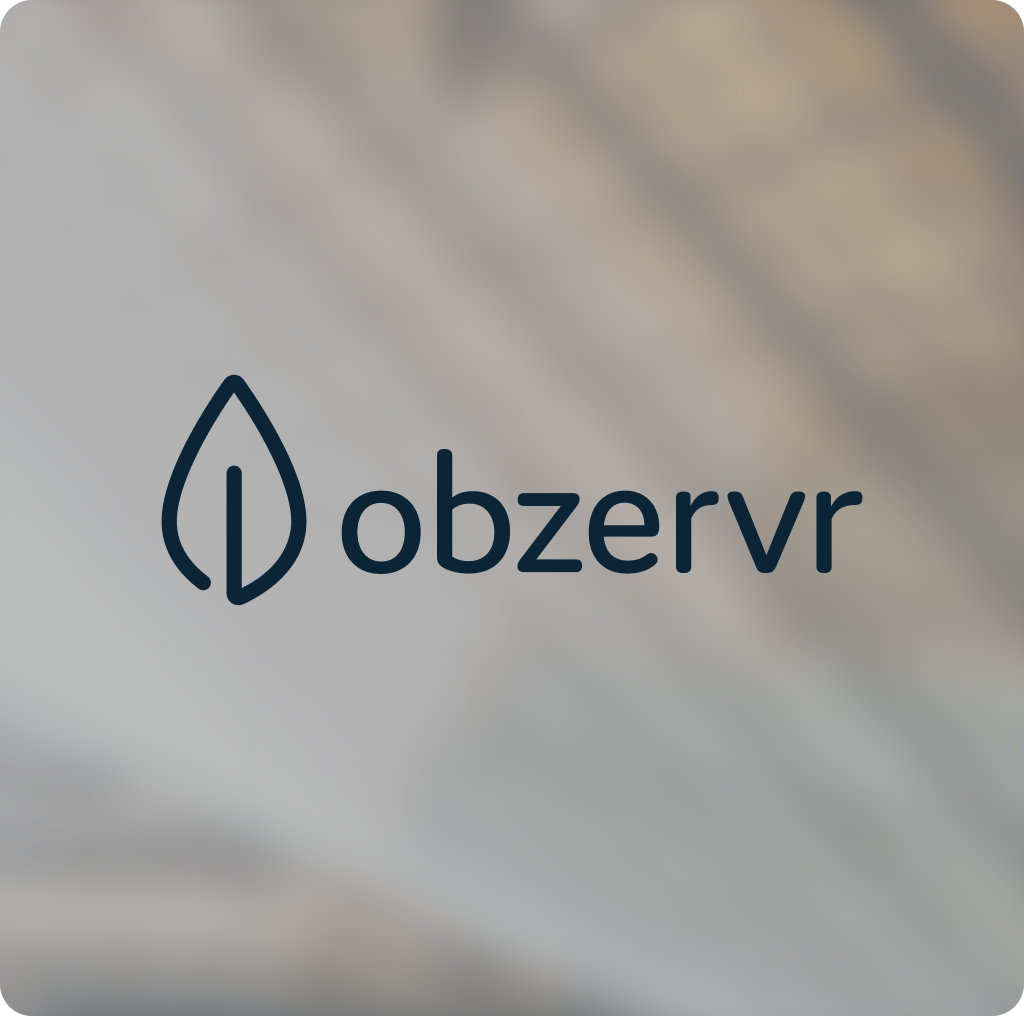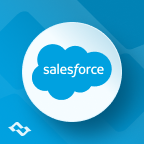I was recently browsing for great content related to Atlassian on YouTube. While doing this, I found a very recent talk delivered by Atlassian's Chief Revenue Officer, Cameron Deatsch about how Atlassian was building the whole ecosystem of Partners, and Vendors to get to a point where the Platform and the Ecosystem are worth $10B. The talk was presented at SaaStr Annual 2022 conference.
At GetInt we are proud to be a part of the Atlassian Marketplace. Before starting the company, I was working for another Vendor, co-creating the whole ecosystem, building the Partner Program, having talks at Atlassian User Group meetings all around the world, and attending Atlassian Summits. I have a lot of experience with other Marketplaces too, but for now, the Atlassian model is the best by a mile.
This presentation showed why.
Cameron joined the company ~10 years ago when Atlassian was already successful – bringing $100M+ in revenue and having 20,000 customers. Now, the numbers are even more impressive – $3B in revenue with 50,000+ customers.

The goal Atlassian has is to get to $10B+ in revenue.
It all started with 2 ambitious young men, Mike Cannon-Brookes and Scott Farquhar founded the company in 2002. They met at a University, and one day they decided to finance the startup with a $10,000 credit card debt. The first product they launched was Jira, and two years later they added Confluence.
Now, Atlassian is 20+ products, and 10,000+ employees all over the world.

Atlassian is competing in 3 markets.
1. Agile, and DevOps
2. IT Service Management (ITSM)
3. Work management tools
From day one, the people behind Atlassian realized, that it won't be just their products that their target group will be using. In reality, there are a lot of applications for any problem an IT company can have.
It's a fool's errand to think that one Vendor and one Company will be able to solve all the use cases.
That's why it's important to build a product ready to work with other tools that are already on the market and will enter it later on. That means you need to think from a Platform, and Ecosystem perspective – not just your single tool.
To support this, Cameron shared that from the beginning Atlassian is spending under 15% of revenue on Sales and Marketing. Atlassian is focusing on product development and trying to provide self-service support whenever possible. This approach is not new now, but 20 years ago selling enterprise software via the web was not a common thing.
The idea Atlassian had was to make the journey from the problem, to the solution as quickly, and frictionless as possible. No web forms, no talks with the sales rep, and so on. Then, they wanted to make sure that any problem the customer may have is already addressed in the form of content marketing or in the docs. Additionally, Atlassian had pricing easily accessible, and clear non-negotiable rules for all.
Lastly, they wanted the customers to become champions, and share the knowledge among themselves – that's how the community was born, and how the whole new line of business started for many – the consulting companies.
As Cameron is stating, non of this would be possible without the Ecosystem, which consists of 3 players:
1. Solution Partners
2. Marketplace Partners
3. Strategic Technology Partners
Here is a quick summary of what made it all successful.
Introduction
Atlassian is a leading provider of software development and collaboration tools, renowned for its innovative approach and unwavering commitment to customer success. The company’s flagship products, including Jira, Confluence, and Trello, are trusted by millions of users worldwide to streamline workflows and enhance productivity. Atlassian’s dedication to delivering high-quality products and services has fueled its remarkable growth and success. In this article, we will delve into Atlassian’s financial highlights, innovation roadmap, AI and emerging technologies, customer success and support, and more, to understand how the company is building a $10B ecosystem.
1. Atlassian Solution Partners
For an Australian company, working mostly with the US, and EU companies was hard since they weren’t able to provide support in the same time zones. It was 2002-2003, so it wasn’t easy to raise capital and start opening offices all over the world. Hopefully, they found another way – invited Partners to take over.
It was in line with their business goals since they wanted to focus on product development. Atlassian’s first Partners were small companies, using Jira to track their work for their customer’s projects and realized that the customers had similar problems (tracking work). Those small companies started to do the first consulting, and implementation work. Back then, they decided that Atlassian will be the best in the automated-driven self-service product-driven funnel. So the customer would be able to make a choice: self-service, which was possible thanks to the content, guides, and documentation – or working with an external company.
Atlassian apps play a crucial role in this ecosystem, allowing developers and partners to sell applications through the Atlassian Marketplace. This not only provides incentives for creating cloud-based apps but also offers growth and customization opportunities for businesses.
That meant handing over consulting, training, and support in different languages to the Partners, for a margin. Quickly, being an Atlassian Partner became a very profitable business, and the main source of profit was not just from selling the licenses, but in consulting, building apps, training, customization, introducing best practices, and more.
Now Atlassian has 700+ Partners in 84 countries.
If you want your business to go far, build partnerships.
What made the Partnership successful?
- Open up a customer portfolio for Partners. Get them into your customer base first
- Be very clear on what role this channel plays – hand off all the customer relations. Make it clear for the customers too.
- Avoid channel conflicts with internal teams at all costs (when Atlassian started to grow they hired sales and training specialists internally). Still, we’re not giving any reason for a customer to not work with a Partner.
Key insights:
- Being open for a strong ecosystem, open for integrations with other great tools. Platform and the Ecosystem are stronger than just a product
- Keep Sales + Marketing spending under 15% of revenue
- 0 sales interaction sales
- Growth through partnerships, not VCs
- Make sure you highlight the value the Partners bring to your customers
- Strong Partners, and Vendors = strong ecosystem
- Being the best at the automated sales-driven funnel. But, if in-person support is needed, additional legal stuff, security forms, training, different languages support -> handing all of this to Partners
- Result: Hounders of companies approaching Atlassian weekly = all handed over to Partners. Now 700+ Partners
- $1B+ sales just of the Atlassian Licenses from Partners. On top of that a lot of $$$ in Service
2. Atlassian Marketplace Partners
The first version of Jira was far from perfect, and definitely far from beautiful. But from the first day, it had the option to submit a feature request. The demand and the number of feature requests were huge. Customers wanted more than accompany was able to deliver.
So the Founders decided to let the customers build their own features, and introduced a customization layer. It allowed developers to really personalize the product. It resulted in a lot of new apps, and the creators quickly realized that they can make some money there. In the end, Atlassian decided to give the creators space to sell the effects of their work, and that’s how Atlassian Marketplace was born.
Thanks to this move, the customers got thousands of features, ready to install. The Atlassian Marketplace has surpassed $4 billion in lifetime sales, showcasing its success and the value it delivers through partnerships with numerous app developers.
The result? As I once heard, usually customers are paying 50% for the Atlassian license, and an additional ~50% of the budget is spent on apps.
This makes the Marketplace unique – thanks to the fact that the customers are used to paying for apps/plugins, they represent high quality, are well supported, and can grow in features. For enterprise customers, that means trust and security.
Most of the other Marketplaces offer free apps, where the quality is usually low.
Now, Atlassian Marketplace earned $2B+, and $1.5B was paid to the Vendors.
Key insights:
- Strong Vendors are key to the ecosystem. The customer asks > the ability to deliver. Atlassian got a public Jira for feature requests.
- We won’t build it – let the customer build it themselves.
- Result = partners and customers started building plugins, making money on their own.
- Result for the customers – thousands of features delivered instantly, by the whole ecosystem – we won’t be able to do it ourselves (including very industry-specific or tech cases Atlassian would never think of)
- Atlassian branding = customers had trust
- If customers install 2+ apps the retention is getting way higher = better retention is worth more than the commission company gets from sales of the apps
- User experience is in the hand of users
3. Strategic Technology Partners for Enterprise Customers
Very selective, key for growth. A great example is a Partnership with Slack. To make it possible, they killed their own communicator – Stride. Atlassian sold it to Slack in exchange for stocks, and the Partnership which made both companies grow. The largest customers play a crucial role in driving strategic relationships and facilitating cloud migrations, significantly influencing growth and product development. Atlassian has a similar Partnership with Snyk.
Financial Highlights and Growth
Atlassian’s financial performance has been nothing short of stellar, consistently surpassing market expectations. In 2022, the company reported a revenue of $2.80 billion, marking a 34.16% increase from the previous year. Despite a net profit margin of -21.91%, this represented a significant improvement of 34.26% from 2021. One of the standout metrics was Atlassian’s free cash flow, which soared to $253.75 million, a remarkable 183.11% increase from the prior year. With a market cap of $35.09 billion and an average trading volume of 3.48 million, Atlassian’s robust financial health underscores its ability to deliver exceptional value through its suite of products and services.
Innovation and Roadmap
Innovation is at the heart of Atlassian’s strategy, with a clear roadmap focused on delivering cutting-edge products and features. The company has made substantial investments in research and development, particularly in cloud app development, to ensure that its offerings remain at the forefront of the industry. Atlassian’s cloud app development platform, Forge, empowers developers to create and deploy cloud apps with ease, fostering a vibrant ecosystem of new cloud apps. Additionally, the company is leveraging AI and emerging technologies to introduce features that significantly enhance the user experience. By prioritizing customer success and support, Atlassian ensures that its innovations not only attract new users but also drive long-term adoption and satisfaction.
Customer Success and Support
Atlassian’s dedication to customer success and support is a cornerstone of its business strategy. The company focuses on comprehensive onboarding, driving adoption, and ensuring high retention rates. Atlassian’s support services are tailored to deliver exceptional assistance, helping customers maximize the value of their Atlassian products. This commitment is reflected in the company’s impressive customer retention rate of 98%, a clear indicator of the trust and satisfaction among Atlassian customers. By prioritizing customer success, Atlassian not only fosters loyalty but also builds a community of advocates who contribute to the ecosystem’s growth.
In summary, Atlassian’s journey to building a $10B ecosystem is a testament to its strategic focus on innovation, financial health, and unwavering commitment to customer success. By fostering a strong ecosystem of partners and continuously evolving its product offerings, Atlassian is well-positioned to achieve its ambitious goals.
Summary
Success doesn’t happen overnight, but it’s easier when you are thinking not about your product only, but you want to be a Platform company.
Revenue streams from data center apps play a strategic role in the cloud transition process, highlighting the importance of balancing performance and pricing between cloud and data center solutions.
Have a clear plan, and metrics, and show value for every side from day one. Community and ecosystem will always be stronger, than a single company.

























